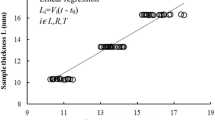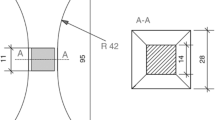Abstract
Ultrasonic testing is a non-destructive testing method of choice for estimating the anisotropic elastic properties of wood materials. This method is reliable for estimating the Young’s and shear moduli. However, its applicability to Poisson’s ratios remains uncertain. On the other hand, despite their destructive nature, mechanical tests allow a direct measurement of all elastic properties including the Poisson’s ratios. In some cases (e.g. when assessing cultural heritage objects), destructive testing may not be an option. In this work, two types of hardwood walnut (Juglans regia L.) and cherry (Prunus avium L.), which often appear on cultural heritage objects, were tested using both ultrasonic and mechanical testing methods under four different moisture conditions below fibre saturation point. The results show that a higher moisture condition leads to a decrease in material elasticity. For walnut wood, their longitudinal Young’s modulus (\(E_{\rm L}\)) was reduced by 679 MPa under the compression load for a one per cent increase in moisture content. Moreover, three ultrasound data evaluation techniques, which differ in the way they incorporate the Poisson’s ratios (full stiffness inversion, simplified uncorrected, and simplified corrected), were used to estimate the Young’s moduli (E). The main goal is to obtain reliable material parameters using the ultrasound test. As a result, it is concluded that the chosen data evaluation method influences the accuracy of the calculated E. In a certain case, the simplified-corrected method, which requires only one specimen type, gave a closer agreement to mechanical tests (e.g. \(\Delta E_{\rm T}=6\,\%\) deviation on mechanical results). In another case, the full-stiffness-inversion method, which requires four specimen types, gave the best estimation (e.g. \(\Delta E_{\rm L}=2\,\%\)). In this corresponding direction, the simplified-corrected method can only partially reduce the overestimation of the simplified uncorrected from \(\Delta E_{\rm L}=47\) to 32 %. The variation of E produced by different evaluation procedures is due to the different correction factor values, which is a consequence of the variation in \(\nu\).






Similar content being viewed by others
References
Ashman R, Cowin S, van Buskirk W, Rice J (1984) A continuous wave technique for the measurement of elastic properties of cortical bone. J Biomech 17(5):349–361
Bodig J, Jayne B (1993) Mechanics of wood and wood composites. Krieger Publishing Company, Malabar
Bucur V (2006) Acoustics of wood, Springer series in wood science. Springer, Berlin
Bucur V, Archer R (1984) Elastic constants for wood by an ultrasonic method. Wood Sci Technol 18(4):255–265
EN12668-1 (2010) Non-destructive testing—characterization and verification of ultrasonic examination equipment—part 1: instruments
Gonçalves R, Trinca A, Cerri D (2011) Comparison of elastic constants of wood determined by ultrasonic wave propagation and static compression testing. Wood Fiber Sci 43(1):64–75
Grosser D, Jeske H (2008) Das Holz der Walnuss—Eigenschaften und Verwendung. http://www.lwf.bayern.de/mam/cms04/forsttechnik/dateien/w60-das-holz-der-walnuss.pdf. Accessed 7 Mar 2015
Hering S, Keunecke D, Niemz P (2012) Moisture-dependent orthotropic elasticity of beech wood. Wood Sci Technol 46(5):927–938
Hörig H (1935) Anwendung der Elastizitätstheorie anisotroper Körper auf Messungen an Holz. Inge Arch 6(1):8–14
Keunecke D, Hering S, Niemz P (2008) Three-dimensional elastic behaviour of common yew and Norway spruce. Wood Sci Technol 42(8):633–647
Keylwerth R (1951) Die anisotrope Elastizität des Holzes und der Lagenhölzer (The anisotropic elasticity of wood and laminated wood) (In German). Forschung auf dem Gebiete des Ingenieurwesens: Ausgabe B, Dt. Ingenieur-Verlag
Kohlhauser C, Hellmich C (2013) Ultrasonic contact pulse transmission for elastic wave velocity and stiffness determination: Influence of specimen geometry and porosity. Eng Struct 47:115–133
Kriz R, Stinchcomb W (1979) Elastic moduli of transversely isotropic graphite fibers and their composites. Exp Mech 19(2):41–49
Ozyhar T, Hering S, Niemz P (2012) Moisture-dependent elastic and strength anisotropy of European beech wood in tension. J Mater Sci 47(16):6141–6150
Ozyhar T, Hering S, Sanabria SJ, Niemz P (2013) Determining moisture-dependent elastic characteristics of beech wood by means of ultrasonic waves. Wood Sci Technol 47(2):329–341
Stamer J, Sieglerschmidt H (1933) Elastische Formänderung der Hölzer (Elastic deformation of woods) (In German). Zeitschrift des Vereines Deutscher Ingenieure 77(19):503–505
Ting TCT, Chen T (2005) Poisson’s ratio for anisotropic elastic materials can have no bounds. Q J Mech Appl Math 58(1):73–82
Zaoui A (2002) Continuum micromechanics: survey. J Eng Mech 128(8):808–816
Acknowledgments
This study was carried out at ETH Zürich and funded through the Swiss National Science Foundation (SNF) project no. 147672.
Author information
Authors and Affiliations
Corresponding author
Rights and permissions
About this article
Cite this article
Bachtiar, E.V., Sanabria, S.J., Mittig, J.P. et al. Moisture-dependent elastic characteristics of walnut and cherry wood by means of mechanical and ultrasonic test incorporating three different ultrasound data evaluation techniques. Wood Sci Technol 51, 47–67 (2017). https://doi.org/10.1007/s00226-016-0851-z
Received:
Published:
Issue Date:
DOI: https://doi.org/10.1007/s00226-016-0851-z




